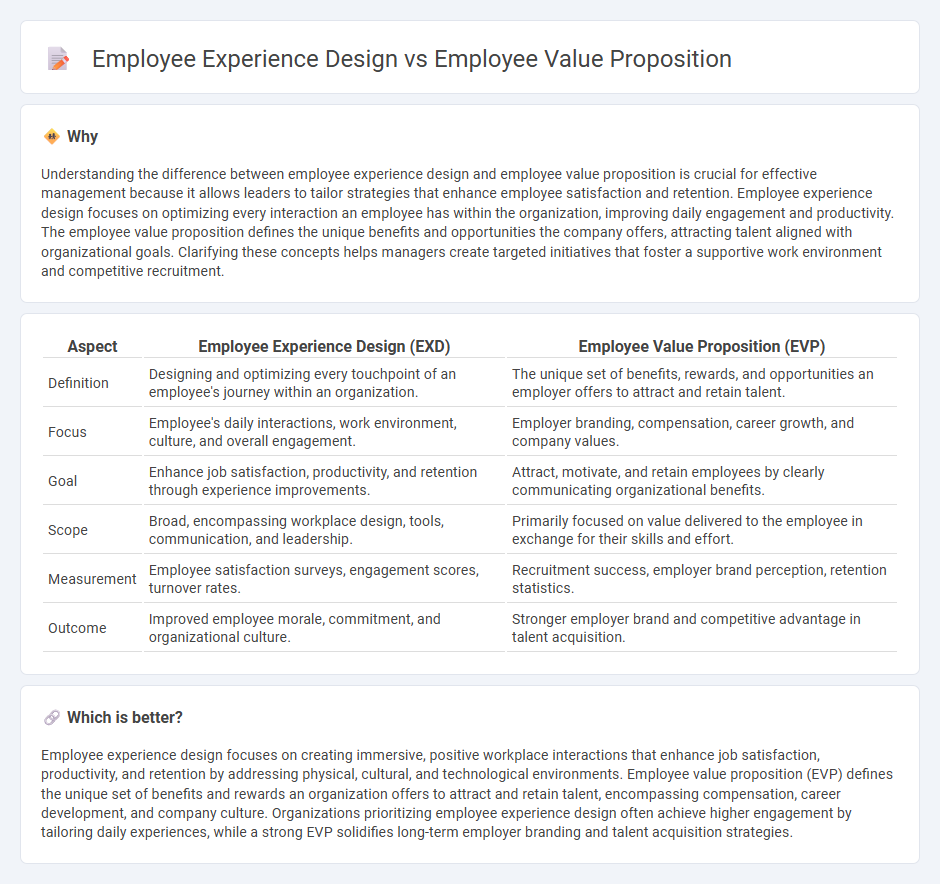
Employee experience design focuses on shaping workplace environments and interactions to enhance job satisfaction and engagement, while employee value proposition defines the unique benefits and rewards an organization promises to its workforce. Integrating both strategies optimizes talent attraction, retention, and overall organizational performance. Explore how aligning these concepts can transform your human resource management approach.
Why it is important
Understanding the difference between employee experience design and employee value proposition is crucial for effective management because it allows leaders to tailor strategies that enhance employee satisfaction and retention. Employee experience design focuses on optimizing every interaction an employee has within the organization, improving daily engagement and productivity. The employee value proposition defines the unique benefits and opportunities the company offers, attracting talent aligned with organizational goals. Clarifying these concepts helps managers create targeted initiatives that foster a supportive work environment and competitive recruitment.
Comparison Table
| Aspect | Employee Experience Design (EXD) | Employee Value Proposition (EVP) |
|---|---|---|
| Definition | Designing and optimizing every touchpoint of an employee's journey within an organization. | The unique set of benefits, rewards, and opportunities an employer offers to attract and retain talent. |
| Focus | Employee's daily interactions, work environment, culture, and overall engagement. | Employer branding, compensation, career growth, and company values. |
| Goal | Enhance job satisfaction, productivity, and retention through experience improvements. | Attract, motivate, and retain employees by clearly communicating organizational benefits. |
| Scope | Broad, encompassing workplace design, tools, communication, and leadership. | Primarily focused on value delivered to the employee in exchange for their skills and effort. |
| Measurement | Employee satisfaction surveys, engagement scores, turnover rates. | Recruitment success, employer brand perception, retention statistics. |
| Outcome | Improved employee morale, commitment, and organizational culture. | Stronger employer brand and competitive advantage in talent acquisition. |
Which is better?
Employee experience design focuses on creating immersive, positive workplace interactions that enhance job satisfaction, productivity, and retention by addressing physical, cultural, and technological environments. Employee value proposition (EVP) defines the unique set of benefits and rewards an organization offers to attract and retain talent, encompassing compensation, career development, and company culture. Organizations prioritizing employee experience design often achieve higher engagement by tailoring daily experiences, while a strong EVP solidifies long-term employer branding and talent acquisition strategies.
Connection
Employee experience design shapes the workplace environment and interactions to enhance job satisfaction, directly influencing the employee value proposition (EVP) by making it more attractive and authentic. A well-crafted EVP communicates the unique benefits and culture employees can expect, which is grounded in the actual experience designed for them. Aligning employee experience design with EVP strengthens talent attraction, engagement, and retention strategies.
Key Terms
Employer Branding
Employee Value Proposition (EVP) defines the unique set of benefits and culture an employer offers to attract and retain talent, serving as the foundation of effective Employer Branding. Employee Experience Design (EXD) focuses on crafting meaningful, engaging workplace interactions and environments that align with the EVP to enhance overall satisfaction and productivity. Explore how integrating EVP and EXD strategies can amplify your Employer Brand and foster a motivated workforce.
Employee Journey Mapping
Employee Value Proposition (EVP) defines the unique set of benefits and rewards an organization offers to attract and retain talent, directly influencing employee motivation and satisfaction. Employee Experience Design (EED) centers on crafting meaningful, seamless interactions at every touchpoint throughout the employee journey, ensuring engagement and productive work environments. Explore how integrating EVP with Employee Journey Mapping enhances workforce strategies and drives organizational success.
Talent Retention
Employee Value Proposition (EVP) defines the unique set of benefits and rewards offered to employees in exchange for their skills, promoting talent retention through clear communication of career growth, compensation, and work-life balance. Employee Experience Design (EXD) focuses on shaping the holistic journey of an employee from onboarding to daily interactions, leveraging feedback and technology to enhance engagement and reduce turnover. Explore how integrating EVP and EXD strategies can significantly boost retention and foster a committed workforce.
Source and External Links
Employee Value Proposition (EVP): All You Need to Know in 2025 - This webpage provides comprehensive insights into the components of an employee value proposition, including compensation, work-life balance, stability, location, and respect.
13 Inspiring Employee Value Proposition Examples That Work - This article highlights how a well-crafted employee value proposition can reduce turnover and improve new hire commitment by offering a combination of rewards and benefits.
Employee Value Proposition (EVP): Definition and Guide - This guide defines an employee value proposition as a statement of values, rewards, recognition, support, and company culture that enables employees to achieve their highest potential.
 dowidth.com
dowidth.com